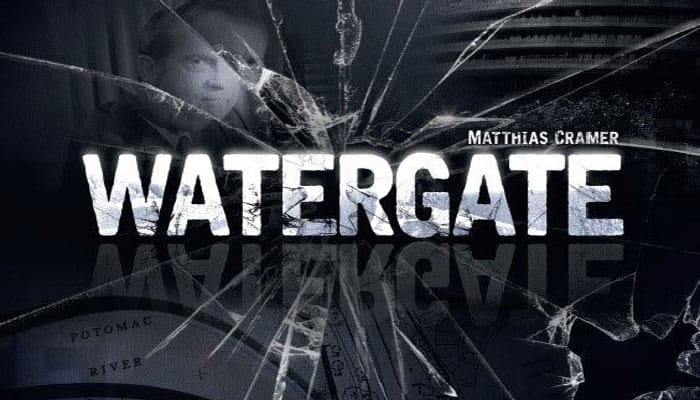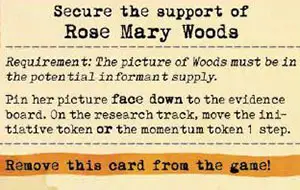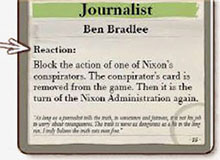
In June 1972, five men are arrested in Washington's Watergate Building. What looks like a third-rate burglary attempt on the headquarters of the Democratic National Committee induces journalists Bob Woodward and Carl Bernstein of the Washington Post to start a thorough investigation.
Over the following two years, they discover that the five men were directed from within the White House to spy on political opponents. As a consequence, in 1974 President Richard Nixon resigns from office to avoid impeachment.
Components

- 1 game board
- 1 momentum card "Nixon Administration"
- 1 momentum card "Editor"
- 20 player cards "Nixon Administration"
- 20 player cards "Editor"
- 1 initiative card
- 1 End of round overview card
- 9 momentum tokens
- 1 initiative token
- 36 evidence tokens
- 7 picture tiles
- 1 bag
- Rulebook
Object of the Game
In WATERGATE, one player assumes the role of a Newspaper Editor, while the other embodies the Nixon Administration - each with a unique set of cards.
To win, the Nixon Administration must build up enough momentum to make it to the end of the term, whereas the Editor must gather enough evidence to connect two informants directly to the President.
Of course, the administration will do all in its power to smother that evidence. Can the secret source known as "Deep Throat" tip the scales? A thrilling race against time begins...
Setup
Determine who will play the Editor and ' who will play the Nixon Administration (from now on referred to as "Nixon").
Place the game board
Abetween you so that the Editor can see the board the right way up, while Nixon looks at it upside down.Take the 21 cards of your role.
Place your momentum card
Bface up next to the research track on your side of the board.Shuffle your 20 player cards and place them as your personal draw deck
Cface down in front of you.Beside the 0 space of the research track, place the initiative card
Dface up between the two momentum cards so that its arrows point towards the Editor. Place the End of round overview cardEnext to it.Place the initiative token
Fand 1 momentum tokenGon the 0 space of the research track. Beside the board, form a supply for the remaining 8 momentum tokensH.Create a supply for the 7 picture tiles
I. This supply is called the "potential informant supply".Put the 30 evidence tokens
Jin the bagKand place the bag nearby.

Game Play
Watergate is played over a series of rounds. Each round comprises the following 3 phases:
-
Initial Phase
Players draw their hand cards for the round and new evidence tokens are placed onto the research track.
-
Card Phase
Players alternate playing and resolving 1 card at a time until they have no' cards left in hand.
-
Evaluation Phase
The initiative, momentum, and evidence tokens on the research track are awarded depending on whose side they are on.

The game ends immediately with a win for Nixon if: Nixon has managed to place a total of 5 momentum tokens on their momentum card.
The game ends immediately with a win for the Editor if: At least 2 informants (face-up picture tiles) on the evidence board are connected via face- up evidence tokens to Nixon's picture in the center.

A. Initial Phase
Carry out the following 2 steps:

-
Both players: Look at the side of the initiative card that points towards you and draw that many cards from your personal draw deck: either 4 or 5 cards.
Put these cards in your hand, concealing them from your opponent.
If your personal draw deck runs out, shuffle your discard pile (formed during the game) and place it as the new face-down draw deck in front of you.
-
Nixon only: Draw 3 evidence tokens from the bag and ' look at them in secret. Then place them face down onto the 0 space of the research track.
Nixon may look at face-down evidence tokens on the research track at any time. The Editor may not.
B. Card Phase

Starting with the player who has the initiative (the player that the arrows on the initiative card are pointing towards), the two of you take alternating turns until neither of you has any cards left in hand.
On your turn, you must play ONE card from your hand.
Each card consists of two parts:
- a value part
- an action part.
Of these two parts, you must choose ONE to use.

Note: Each card also shows a quote at the bottom that has no relevance to the gameplay.
Value Part
If you choose to use the value part, move 1 token on the research track as many spaces towards your side as that value states (1 to 4).|
You can choose either the initiative token  , the momentum token
, the momentum token  , or an evidence token.
, or an evidence token.
If you move an evidence token, bear the following rules in mind:
There are 3 basic types of evidence token, each with a specific color:
- Blue (represents checks for Nixon's re-election campaign)
- Yellow (represents ground-plans of the Watergate complex)
- Green (represents transcripts of the Nixon White House tapes)
There are also two-colored evidence that can be used as either of their tokens colors.

When you use the value part of your card to move an evidence token, it must be a token of the color shown on that card A or a two-colored evidence token that includes that color.
If your card shows a joker (with all 3 colors) B, you can move 1 evidence token of any color.

To move a face-down evidence token, also note the following:
-
As Nixon, to move a face-down evidence token with the color shown on your card, simply flip the token face up and move it accordingly. (Remember that you can always look at face-down evidence tokens).
-
As the Editor, if you want to move a face-down evidence token, ask Nixon if there is any with the color on your card (if the card shows a joker, name a color).
If there is a face-down token with that color, Nixon must flip it face up and move it the appropriate number of spaces towards your side. If there are more than one such tokens, Nixon chooses which of them to flip and move.
If there is no face- down evidence token with that color (and Nixon tells you so), you may instead move either the initiative token, the momentum token, or an already face-up evidence token with that color (or - in the case of a joker - any color).

Important: After you use a card's value part, discard it face up to your personal discard pile. (If it is your first discarded card, place it face up beside your draw deck to create your,discard pile).

Moving a token to space 5 on your side:
Whenever you manage to move a token to space 5 on your side of the research track, any extra steps are forfeited and you gain that token immediately.
If you gain a token this way, follow the instructions in the green box of that token's type.
Attention: As soon as a token has been gained, it is gone from the research track and thus can't be moved anymore.
Action Part
If you choose to use the action part of your card, follow the printed instructions.
There are 3 types:
-
Events
Most cards in the game feature an event. Events must be removed from the game (e.g. to the box) after you use their action part. Only the event "Gambit" provides an alternative.

-
Conspirators
Only Nixon has conspirators. After Nixon uses the action part of a conspirator card, it goes to Nixon's discard pile.

-
Journalists
Only the Editor has journalists. After the Editor uses the action part of a journalist card, it goes to the Editor's discard pile.

Attention:
Some cards state requirements which must be met in order to use their action part.
Some cards are reaction cards. You can only use their action part as a direct reaction to a specific card played by your opponent.
Important: When following a card's instructions, you have to fully carry out all instructions that are possible. Instructions that cannot be carried out (because, for example, a token that you are supposed to move is not present) can be ignored.
Some of the most common instructions
-

If an instruction tells you to move a specific token "X steps", move that token on the research track that many spaces towards your side.
-

If an instruction states a space of the research track, move the token to that space.
-

If an instruction tells you to move evidence tokens, you can choose among all those on the research track, whether they are face up or face down (unless the instruction clearly states otherwise).

Attention: Whenever you move a face-down evidence token you must flip it face up.
-

If an instruction tells you to "pin a picture to the evidence board it means that you must take the picture tile of the person named from the potential informant supply and place it onto that person's informant space (which is marked with that person's last name).
The Editor always places picture tiles face up (as recruited informants), while Nixon places them face down.

-

Further Notes:
At any time, both of you may look at face-down evidence tokens that are already on the evidence board.
At any time, both of you may look at the cards of either discard pile and any cards already removed from the game (but never those of the face-down draw decks).
C. Evaluation Phase
Once neither player has any cards left in hand, carry out the evaluation phase by following these 5 steps in order:
1. Return neutral evidence tokens to the bag
If there are any evidence tokens left on the 0 space of the research track (face up or face down), return them to the bag.

2. Award this round's initiative token
Give the initiative token to the player whose side of the research track it's on.
Gaining The Initiative Token
When you gain the initiative token, take it from the research track and place it onto the initiative card. Then turn the initiative card (if necessary) so that its arrows point towards you. This indicates that you have the initiative now.

If the initiative token is on the 0 space of the research track, it is gained by the player that did not have the initiative this round.
If the initiative token was gained earlier this round, skip this step.
3. Award This Round's Momentum Token
Give this round's momentum token to the player whose side of the research track it's on.
Gaining the momentum token
When you gain this round's momentum token, take it from the research track and place it onto your momentum card on the empty space with the lowest number. If there is an instruction text next to that space, carry it out now.
If the Editor gains the momentum token but has no free space on the momentum card, remove that momentum token from the game!

If the momentum token is on the 0 space of the research track, it is not gained by either player but returned to the supply instead.
If the momentum token was gained earlier this round (see page 6), skip this step.
4. Place the initiative token and 1 new momentum token onto the 0 space
Take the initiative token from the initiative card and place it onto the 0 space of the research track.
Then take 1 momentum token from the supply and also place it onto the 0 space of the research track. If you can't do so because the: is none left in the supply, Nixon wins the game immediately.

5. Award this round's evidence tokens
Finally, each player gains any evidence tokens that are on their side of the research track. The player with the initiative begins and pins all evidence tokens from their side (if any) to the evidence board (see the green box below). Then the other player does the same for any evidence tokens from their side.
Pinning an evidence token to the evidence board
Whenever you gain an evidence token (or are instructed by a card to pin one to the evidence board), place it onto any empty evidence space that is marked with a slip of that token's color (or - in the case of a two-colored token - one of its two colors).
If you are the Editor, place it face up (to create connections). If you are Nixon, place it face down (to disrupt connections).
Attention: If the evidence token shows this symbol
also move the momentum token on the research track 1 space towards your side.
If no player has won the game yet (see below), start a new round.
End of the Game
The game ends immediately with a win for Nixon:
-
as soon as Nixon places a fifth momentum token onto their momentum card
-
or, in rare cases, if no momentum token is left in the supply to be placed on the research track during step 4 of the evaluation phase.


The game ends immediately with a win for the Editor:
as soon as the Editor has connected Nixon to at least 2 informants on the evidence board.
An informant is considered connected to Nixon if a thread coming from that informant's face-up picture tile runs all the way through face- up evidence tokens to Nixon's picture in the center (empty spaces and face-down evidence tokens disrupt connections).
Continue Reading



